Asif M Basit, Ahmadiyya Archive and Research Centre
As Hazrat Khalifatul Masih Vaa arrives back from America, we take a brief look at what makes the Ahmadiyya message to the USA so special.
“It is now clear that the attacks on the American homeland and the responses to them have created a new prism of global affairs, a tension between a state and a religion that plays out on an international level as never before. Relations between the world’s undisputed superpower and the world of 1.4 billion Muslim believers can only be viewed as inexorably changed since 9-11.”
This is an analysis by Peter W Singer, a foreign affairs analyst and director of the Twenty-first Century Defense Initiative at the Brookings Institute. Published five years after the infamous 9/11 attacks, it remains true today, twenty-one years on.
Although the 9/11 attacks have worked as a turning point in souring the relationship between Islam and America – or the entire West, for that matter – history cannot be ignored when it tells a different story.
One might agree with Springer in that the relations between America and Islam have “inexorably changed since 9-11”,1 but Maxime Rodinson speaks loud enough to catch our attention when he says that “Western Christendom perceived the Muslim world as a menace long before it began to be seen as a real problem.”2
Thus, the issue that has come to be seen as a purely political one has its roots, and deep ones, in the encounter of two conflicting faiths. Albert Hourani notes that Christians had for centuries held that “Islam is a false religion, Allah is not God, Muhammad was not a prophet; Islam was invented by men whose motive were to be deplored, and propagated by the sword.”3
Fawaz Gerges traces the roots of this impression to crusaders like Oliver of Paderborn, who very plainly declared that “Islam began by the sword, was maintained by the sword, and by the sword would be ended.”4
This Christian-Muslim conflict had swollen to a stage where they were seen as both “contending for the mastery of the human race.”5 Held together by spiritual and material ties of certain commonalities in faith, Christians and Muslims gradually turned into a religiopolitical and military challenge for each other6 and remain so to this day. What has changed, though, is that Islam remains Islam while its contender has shortened its identity from Western Christendom to “The West” – becoming more of a geopolitical and cultural phenomenon than a faith.
America’s first rendezvous with Islam
While some studies suggest that Islam had touched the shores of America even before Christopher Columbus’ expedition, more authentic works tend to suggest the first migration of Muslims to America happened in the three centuries of the slave trade, where “an estimated 10 to 50 per cent of the ten million Africans brought to these shores against their will were Muslims.”7
These generations of Muslim slaves – “five chronologically overlapping generations,”8 as Ira Berlin classes them – had remained victims of “a system of domination of human beings that was endorsed by the state”.9
Even after the 13th amendment of the US constitution in 1865 – that resulted in the abolition of slavery – and the subsequent 14th and 15th amendments that established equal rights of citizenship, this tweaking of the constitution could not erase the hard line that segregated the slaves – mostly of African origin – from the rest of society.
Colour was not the only dividing line after the Reconstruction. The mass conversions of slaves to Christianity – usually under government orders10 – meant that the abolition of slavery thrust into society a huge population belonging to two major circles: Former slaves who were Christian and those who were ‘heathen’. The heathen were in the minority, of which the Muslims formed a fraction. Studies suggest that most African slaves “adhered to non-Islamic beliefs”.11
It was not only the body of state agencies that undertook conversion and baptism, but missionaries from various Christian denominations remained devoted towards this cause.12 This meant that when freed, these slaves had an in-group where they could find a sense of belonging and, hence, find it easier to integrate into society at large. This was not the case for Muslim converts.
Studies on Muslim slaves – limited and narrow as they have remained – have found that this religious class not only practised their faith within their families but also that “they may have converted slaves who were not relatives”.13 While Christian conversions happened under the controlled and organised efforts of dedicated bodies, Muslim conversions remained confined to individual, personal circles. Hence, observes Gomez, “As Africanized Christianity became more of a force, Islam necessarily suffered”.14
The politics behind converting slaves to Christianity, yet reluctance to have them baptised for the rights that the latter could potentially offer, is not the scope of this essay. Thus, we refrain from it and move straight to looking at American society, with a huge population of African origin, and the predicaments that existed therein.
The Reconstruction era that ensued the 13th, 14th and 15th Amendments might have granted African Americans equal rights to citizenship, but laws cannot govern certain elements of the human mind. The sentiment of racial supremacy, or any sense of supremacy for that matter, lives deeper in the psyche than apparent gestures of goodwill.
What came twined with the Reconstruction, was the Redemption Movement, where White Americans, in the Southern states particularly, called for any legislation giving equal rights to the Black population to be repealed. The pressure was immense – violent and militant in nature – and most of the Southern states saw themselves slip back into their pre-Reconstruction patterns.15 American sociologist DuBois describes this phase as such:
“The slave went free; stood a brief moment in the sun; then moved back again toward slavery.”16
This era of existential crisis started with the Reconstruction (the last decade of the nineteenth century) and lasted until the early decades of the twentieth century.17 Historian Rayford Logan termed the coin “Nadir” for this era – meaning the lowest point.
It was in this state of “Nadir” – a very crucial point in American society – that an Indian-Muslim missionary arrived in America. Interesting it is that the word “Nadir” in Arabic means “precious” and “unique”.
Ahmadiyya Muslim mission to America
The Ahmadiyya is a reform movement in Islam established on the belief that the founder, Hazrat Mirza Ghulam Ahmadas, was the Promised Messiah of the latter days. Founded in 1889 in the British-Indian-Punjab, the Ahmadiyya had become famous for its missionary zeal through its outreach programme through being the first to establish an organised mission in London at the onset of the twentieth century – 1912 to remain precise.
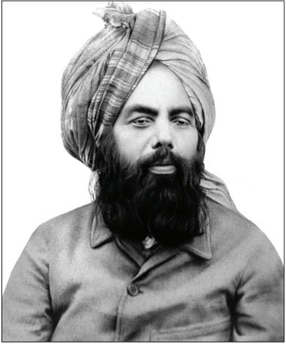
One of the early missionaries sent to the London mission was Mufti Muhammad Sadiqra. The London mission had been established based on a dream of the founder of the Ahmadiyya community where he had seen himself speaking to a large gathering in London. He saw that he had caught some white birds. Zealous to materialise the dream, albeit posthumously, his first successor, Hazrat Maulvi Nuruddinra had gone beyond the community’s humble resources to establish a mission in London.
The success of the London mission in proselytising Islam in Great Britain proved very encouraging. By 1919, the second successor and son of the founder, Hazrat Mirza Bashiruddin Mahmud Ahmadra, saw a dream that he narrated to his congregation in Qadian in March 1919:
“I saw that the Promised Messiah hurriedly enters the house. I say to him, ‘You have come after a very long time. Please stay for some time.’ He replied, ‘No. I cannot stay. I have lived in America for five years and am now headed to Bokhara.’ From this, I have implied that America is now ready to accept the truth […] and, therefore, a mission should definitely be established there.”18

Hazrat Mufti M Sadiqra arrived in America in the spring of 1920, but before his arrival, the stage had been set for Ahmadiyya Islam to be introduced to the Americans. Richard Turner states:
“The roots of a new American Islam can be traced to modernist reform in the Indian Ahmadiyya Movement in Islam. In the nineteenth century, the Ahmadis began to formulate plans to revitalize Islam as a world religion by missionizing the Western hemisphere. Although they did not formally begin their work in America until 1920, the spirit of their movement was embodied in the activities of a white American named Mohammed Alexander Russell Webb, the primary representative for Islam at the World’s Parliament of Religions.”19
This Parliament of Religions was held in Chicago in 1893. Reports indicate how this European-American Muslim was booed by the audience when he spoke about the permission of polygamy in Islam.20 He managed to introduce other aspects of Islam and closed his presentation with the following words:
“There is no system that has been so wilfully and persistently misrepresented as Islam, both by writers of so-called history and by the newspapers and press. I feel that Americans […] are disposed to go to the bottom [of the] facts […] and when they have done so, I feel that we shall have a universal system which will elevate our social system to the position where it belongs.”21
Webb spoke in a climate where the winds of hatred against Islam were too gusty to even walk a single step. Americans had generally come to see Islam as “mysterious, unchanging and ultimately inferior”.22
What sadly sums up the American view of Islam are the words of a comedian who had attended the meetings of the Parliament of Religions and had observed the Muslims pray:
“A lot a fellers was blacker than a pair o’shoes on Sunday morning […] You can’t tell whether they’re at prayer or a dog fight, but I suppose it’s all the same in Arabia.”23
Webb had identified one particular area that, if fixed, could change the image of Islam in American thought: Islam is not a religion of the sword. That Jihad no longer meant fighting with the sword but through peaceful means of dialogue was, and remains to this day, the biggest jewel in the Islamic understanding of Hazrat Ahmadas. Webb was introduced to Islam through Hazrat Ahmadas, as he clearly stated in his letter to the former:
“After reading your circulars, an idea occurred to me which I will present to you for your consideration, knowing or rather feeling confident that you, who are so much more spiritual than I, so much nearer to God, will answer me in a way that will be for the best.
“[…] The public mind, I think, is now more than ever fitted to receive Muhammadanism as well as Buddhism and it may be that through you it is to be introduced in my country. I am convinced that you are very much in earnest. I have no reason to doubt that you are inspired by God to spread the light of truth […]”.24
The above is from his letter dated 24 February 1887, replied to by Hazrat Ahmadas on 4 April 1887. Although Webb never became a registered follower of Hazrat Ahmadas, historians agree that his correspondence with the latter played a key role in his conversion to Islam. This correspondence is from the years leading up to the Parliament of Religions (1893) where Webb had introduced the American minds to Islam – the Ahmadiyya Islam.
Thus, the dawn of the Ahmadiyya mission in America happened at a time when the American mind generally despised Islam, and the African American soul, in particular, was faced with an existential crisis – or, as rightly termed by Logan, had sunk to the “nadir” of its existence.
The ethos of the Ahmadiyya mission to America can be summarised, in the words of Jane Smith, as follows:
“The first Ahmadi missionary to the United States was Mufti Muhammad Sadiq in 1920. He began a society for the preservation of American Islam and in 1921 started publication of the periodical Moslem Sunrise […]
“Ahmadi missionaries played a significant role in the early decades of the century in attacking what they saw as the blatant racism of American society.”25
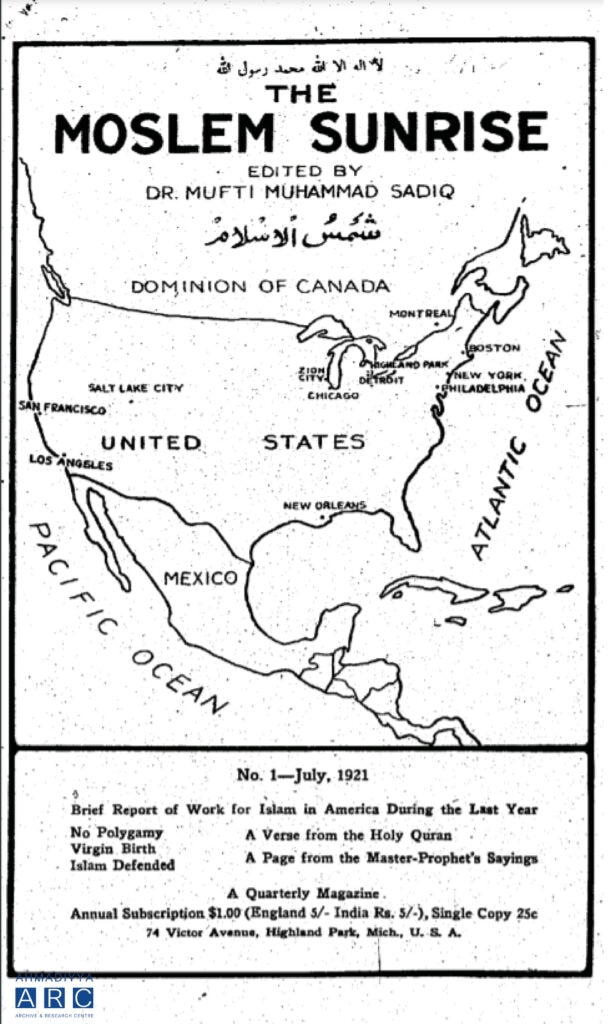
To sum up, the Ahmadiyya mission sought to demystify Islam for American understanding, proselytise the peaceful version of Islam as taught by Hazrat Ahmadas, and tackle the chronic issue of racism in American society.
Historians see this mission of Hazrat Ahmadas to be the first in modern history “to reach the New World, and his teachings opened up novel spiritual possibilities for many”.26
Moustafa Bayoumi sees the story of the Ahmadiyya mission to America as “particularly unusual”27 as the mission styled itself as “pioneers in the spiritual Colonization of the Western world”.28
Bayoumi takes the latter quoted line from the message of Hazrat Mirza Bashiruddin Mahmud Ahmadra, the then head of the Ahmadiyya community, that he sent for the Americans and published in the first issue of The Moslem Sunrise. It is important to present the message in full as it places the Ahmadiyya ambition for America in perspective:
“The Pioneers in the Colonization of American land are always looked back upon with great honor and respect. Their work was temporal but now, my dear Brothers and Sisters, Allah the Almighty has made you the Pioneers in the spiritual Colonization of the Western world. If you will work with the same love, zeal, sincerity and loyalty as they did your honor and respect and name will be still greater than their’s, as you will have moreover the Reward at the Last day and Allah’s pleasure, the grandeur and beauty of which no one can estimate here in this world. Mirza Mahmud Ahmad”.29
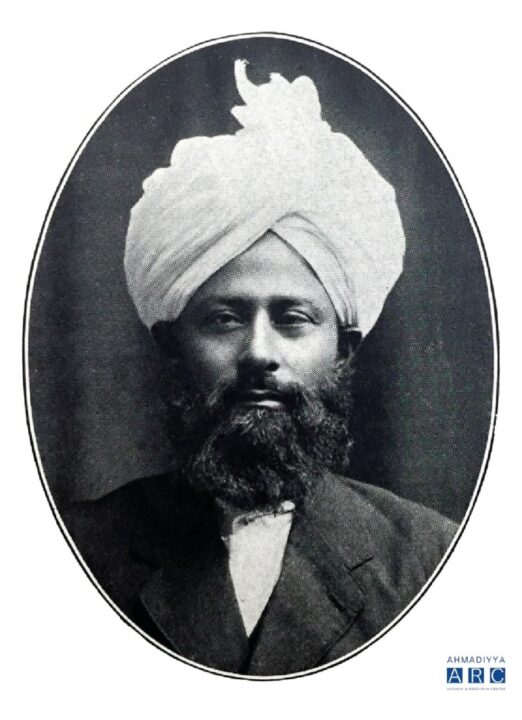
This message clearly defined the Ahmadiyya manifesto and agenda towards America – all about spiritual well-being and no political interests. This set the Ahmadiyya mission aside from being classed as what is now known as “political Islam”; the same remains to this day.
Hazrat Mufti M Sadiqra made full use of his publication, The Moslem Sunrise, to quell the impression of which he had personally become a victim. Upon arrival on the American shore, he was refused entry for being an adherent of a faith that permitted polygamy. It took many weeks for his plea against the decision to be heard by the authorities before he could be set free from detention and let out into American society.30
This image of Islam in the American mind many decades before 9/11 was not much different to what it is in the post-9/11 era of America-Muslim relations – a radically charged political force against the West.
In a society where racism had become the greatest vice, the Ahmadiyya mission emerged as “unquestionably one of the most significant movements in the history of Islam in the United States in the twentieth century, providing as it did the first multi-racial model for American Islam.”31
The Ahmadiyya mission signified what it stood for: A Jihad through words, not swords. The publication of The Moslem Sunrise stirred a new wave of re-introducing Islam to the American mind, as Turner observes:
“The Ahmadis disseminated Islamic literature and converted black and white Americans. They attacked the distortions of Islam in the media, established mosques and reading rooms, and translated the Quran into English.”32
But introducing the multi-racial model of Islamic pluralism did not prove an easy sail for the Ahmadiyya mission. Although Hazrat Mufti Sadiqra had succeeded in converting a significant number of Americans, black and white both, he faced tough resistance in bringing Americans to accept Islam as a part of their own society. His frustration can be felt in his editorial columns of The Moslem Sunrise in a few months’ time from its launch. He was experiencing an innate resistance to Islam by the American society – a resistance best described by Eric Lincoln:
“Being ‘American’ presupposes the Judeo-Christian heritage of experience […] and the religion of Islam is not in any substantial way a part of the critically valued American experience.”33
However tough the status quo was, the Ahmadiyya mission had not arrived to retreat. Mufti Sadiq had made this clear to the immigration officials at the point of his very arrival in America when they attempted to deport him back to India. Identifying this “Judeo-Christian” basis for eligibility to be seen as American, the Ahmadiyya mission focused on introducing the truth about Christianity, and about Christ himself for that matter – it was a vital part of the Ahmadiyya belief anyway.
The Moslem Sunrise set out on a mission to introduce the alternative understanding of the orthodox Christian Jesus. According to the Ahmadiyya belief, Jesusas had not died on the cross, had survived the crucifixion and lived to preach his mission. And that he had later died a natural death.34
This Ahmadiyya Jesus made perfect sense to many Christians and it started to attract followers in amazing numbers. The Moslem Sunrise would carry lists of converts as well as their correspondence with the Ahmadiyya mission in America.
Sinclair Upton’s novel “They call me carpenter” had as its lead character a Jesus who returns to the modern world to learn that while he is worshipped by millions, he still finds no place in the modern world. This novella was serialised by The Hearst’s International from July to October 1922, before being published in book form.
Sinclair believed, as he stated in his other works quite plainly, that Jesus was very human and not the divine son of God. The Moslem Sunrise published a review of Sinclair’s work, highlighting how White Americans too were weary of the Christian orthodox persona of Jesus.
The Ahmadiyya mission had read the pulse of the Western world in general and the American mind in particular. It carried articles like “The supreme need of the hour” which brought to light how priests and missionaries were all longing for an “adequate spiritual leader” and that “the Master at the door” and urging people to open their “eyes and recognize him”.
By the time Mufti Sadiqra left America in 1923, the Ahmadiyya message of Islam was well-engrained in the American mind.
The mission continued to demystify Islam, preach the truth about the second coming of the Messiah and call the American peoples to Islam Ahmadiyya. The mission published many books and epistles for this purpose and distributed them among the American population. Mosques were built and missionaries were appointed in all their mosques to address any queries that the American people may have.
The 9/11 turning-point
Then came 9/11 and the Ahmadiyya contribution towards demystifying Islam had to be accelerated manifold. This meant the mission statement remained the same but had to be disseminated at a much larger scale and that too, in a world where media propaganda against Islam was at an all-time high – not to speak of the unimaginable levels reached by the birth of social media on an already murky horizon.
The 9/11 attacks of 2001 led the West, spearheaded by the media, to revisit Islam and refashion it to be seen as a religion that incites and practices violence. Brutality and inhumanity were painted as the two representative features of Islam. It was portrayed as a political power that aimed to gain control, through fair or unfair means, of the whole world, particularly the West.
It was only two years after these attacks that Hazrat Mirza Masroor Ahmadaa assumed office as global head of the Ahmadiyya Muslim community. The 9/11 attacks were still a painful scar and a basis for aversion towards Islam. Islam faced the biggest challenge of its history, the age of the Crusades inclusive.
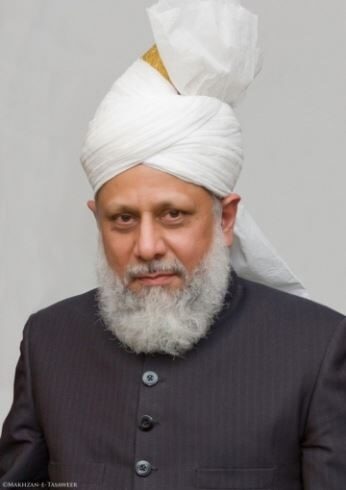
The Ahmadiyya Muslim Community, under the leadership of Hazrat Mirza Masroor Ahmadaa, took it upon itself to dispel such a derogatory image of the whole body of Islam. Hazrat Mirza Masroor Ahmadaa made it clear to the world that the “terrorists have no knowledge of Islam”.35 He told the world it was not Islam that prompted violence and terrorism but, “Muslim leaders and their so-called religious scholars are blinded to Islam’s true teachings and are leading their nations on a destructive and ruinous path.”36
Addressing the US Congress at Capitol Hill in 2012, Hazrat Mirza Masroor Ahmadaa reminded the superpower of the world that “God Almighty has made it clear that whilst our nationalities or ethnic backgrounds act as a means of identity, they do not entitle or validate any form of superiority of any kind.”37
Speaking to the dignitaries of the Congress, he reminded them clearly and plainly that “all people should be granted equal rights without any discrimination or prejudice” and that “the United States […] should play its role in acting with true justice”.38
After almost a century of consistent efforts, the Ahmadiyya message of Islam is now more warmly welcomed by the American nation than ever.
Upon his visit to the House of Representatives in 2012, a resolution was passed in his honour, that read:
“Welcoming His Holiness, Hadhrat Mirza Masroor Ahmad, the worldwide spiritual and administrative head of the Ahmadiyya Muslim Community, to Washington DC, and recognizing his commitment to world peace, justice, nonviolence, human rights, religious freedom and democracy.”39
This warmth of acceptance encouraged the Ahmadiyya Muslim community to further enhance their efforts of spreading the peaceful message of Islam to the American people. Mosques began to dot the skylines of many towns and cities in the US, with Hazrat Mirza Masroor Ahmadaa visiting frequently and laying their cornerstones and inaugurating them. Such events have seen dignitaries, from local authorities to the federal government alike, attending and expressing their acknowledgement of the peaceable message of Islam brought to them by the Caliph of the Ahmadiyya community.
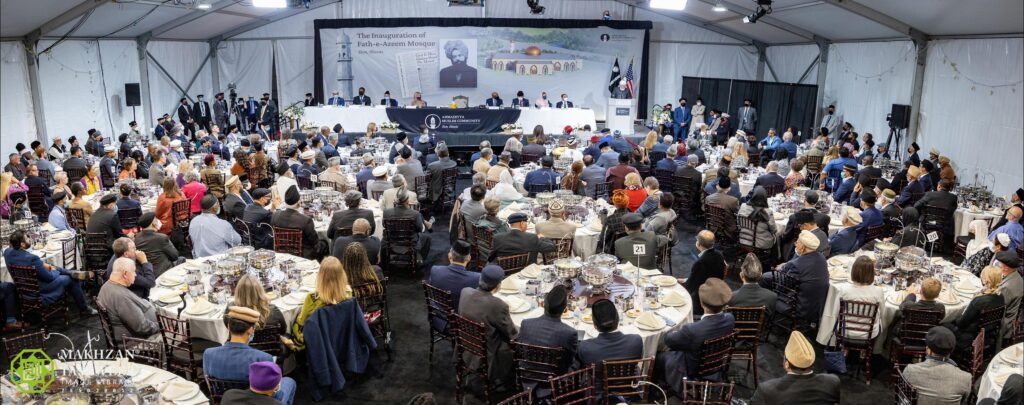
Most recently, the American nation has seen two new Ahmadiyya mosques emerge in two states: one in Zion, Illinois and the other in Allen, Texas.
Addressing a reception to mark the inauguration of The Great Victory Mosque (Masjid Fath-e-Azeem) in Zion, Hazrat Mirza Masroor Ahmadaa reiterated the Ahmadiyya message of Islam:
“Our only mission and our sole aspiration is to win the hearts of mankind through love and to bring people closer to God Almighty. So to become true worshipers of Him and fulfil the right of one another.”
This statement is representative of the Ahmadiyya understanding of Islam and clearly removes Islam from the political tug-of-war and places it where it belongs: Spiritual and moral realms of human well-being.
With this call to God Almighty, Hazrat Mirza Masroor Ahmadaa made it clear that the Ahmadiyya hope and objective remained undeterred:
“It is the paramount objective of the Ahmadiyya Muslim Community to direct mankind to the path of spiritual salvation and to ensure that all people irrespective of their cast, creed or colour live together with the spirit of goodwill and harmony and in true peace and security.”
The Mayor of the City of Zion, Hon Billy McKinney, welcomed Hazrat Mirza Masroor Ahmadaa and expressed his thoughts about the Ahmadiyya community:
“Blessed to be guided by His Holiness, the community has reached out to people of all faiths with a message of peace, justice, universal human rights and service to humanity. So, it is with deep gratitude for the outstanding services rendered by the Ahmadiyya Muslim Community […] that we present the key to the City of Zion to His Holiness.”
Addressing the inaugural reception of Bait-ul-Ikram Mosque in Allen, Texas, US Congressman Michael McCaul (Texas, 10th District) expressed his views before Hazrat Khalifatul Masih Vaa and the dignitaries that comprised the audience:
“It was the Ahmadiyya Muslims that stood up for the United States of America after 9/11; it was the Ahmadiyya Muslims that stood up for freedom of religion […] so I say congratulations on this mosque.
“[…] With His Holiness, I talked about the teachings of Jesus, the teachings of Ahmadiyya, the New Testament, the gospels […] I think we can learn a lot from the Ahmadiyyas.”
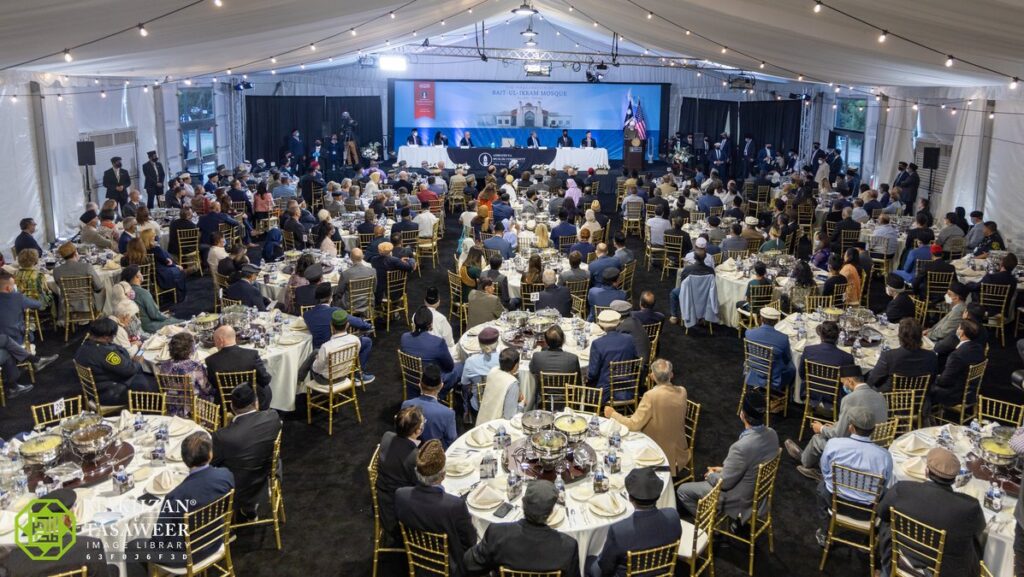
Despite the welcoming words of the dignitaries that spoke on these occasions, Hazrat Khalifatul Masih Vaa understood well the underlying concerns that the local residents might have about Islam, not to speak of having a mosque erected amidst their neighbourhood. In very simple and plain words, he addressed the issue:
“Indeed, when we have built mosques in other places, some people expressed their fears or reservations that the new mosque and increased presence of Muslims might lead to being a detriment to the peace and security of their town or city. If anyone holds such concerns, I wish to immediately reassure them that a sincere Muslim who understands and values Islam’s teachings can never act in a way that defames or misrepresents Islam, he can never be a cause of grief or distress for non-Muslims.”
The message he left for the residents of Texas summarised the missionary activity of the Ahmadiyya Muslim community in not only the US but the whole wide world:
“A true Muslim is one who shoulders the burden of others and feels their pain and sorrow as though it were their own. So it is with this spirit of sympathy for all mankind and an understanding that Allah the Almighty’s grace and mercy are universal that we build mosques.”
Conclusion
A journey that started a century ago remains consistent: Equality, peace, justice and, above all, connecting to the Creator of mankind.
So true were the emphatic words of Mufti Muhammad Sadiqra when, told by the immigration officers that he will be sent back without setting foot in America, he replied: “I am not here to return”.
Mufti Muhammad Sadiqra, during his overnight stay in Liverpool before boarding the steamer to America, had seen in a vision the words:
Fateh Muhammad Bahadur
Meaning: Victory of Muhammadsa, the Great
The words have finally seen fulfilment in the time of Hazrat Mirza Masroor Ahmadaa, when America opened its arms to the message of Islam.
Hence, pre-9/11, or post-9/11, the Ahmadiyya mission of Islam has remained a constant in American society. The resolute steadfastness and relentless, untiring efforts of demystifying Islam and calling people to the only path of salvation have started to show the blossom that will one day fill with its colour the bleak horizon of materialism.
With this, we congratulate Hazrat Khalifatul Masih Vaa, on his very successful tour of America. Long live Khilafat-e-Ahmadiyya!
Endnotes:
[1] Singer, Peter Warren. “America, Islam, and the 9-11 War.” Current History 105, no. 695 (2006): 415–22. https://doi.org/10.1525/curh.2006.105.695.415.
[2] Maxime Rodinson, Europe and the Mystique of Islam, p. 3, Translation by Roger Veinus, IB Tauris, London, 1987.
[3] Albert Hourani, Islam in European Thought, p. 8, Cambridge University Press, New York, 1991.
[4] Norman Daniel, Islam and the West: The Making of an Image, p. 127, Edinburgh University Press, Edinburgh, 1960; quoted by Fawaz Gerges, Islam and Muslims in the Mind of America, in America and Political Islam: Clash of Cultures or Clash of Interests?, Cambridge University Press, London, 1999.
[5] Friedrich Schleiermacher, The Christian Faith, Ed. HR Mackintosh and JS Stewart, English translation, T&T Clark, Edinburgh, 1928.
[6] Hourani, Op Cit, p. 8; John Esposito, The Islamic threat: Myth or reality? Oxford University Press, New York, 1992;
[7] The First American Muslims, The Pluralism Project, Harvard University, www.pluralism.org (accessed on 2 October 2022)
[8] Ira Berlin, Generations of Captivity: A History of African-American Slaves, Harvard University Press, Massachusetts, 2003.
[9] Ibid.
[10] The instructions given by the King of England to the Council for Foreign Plantations, recorded in Documents relating to the Colonial History of New York, III.
[11] Michael A Gomez, Muslims in Early America, in The Journal of Southern History, Vol. 60, No. 4, Southern Historical Association, 1994.
[12] Marcus W Jernegan, Slavery and conversion in the American Colonies, in The American Historical Review, Vol. 21, No. 3, Oxford University Press, 1916.
[13] Gomez, Opt Cit
[14] Ibid.
[15] Details: Reconstruction vs. Redemption, National Endowment for the Humanities, USA, www.neh.gov (accessed 3 October 2022)
[16] WEB Du Bois, Black Reconstruction in America, 1935.
[17] Rayford Logan, The Betrayal of the Negro: From Rutherford B Hayes to Woodrow Wilson, p. 62, Collier Books, New York, 1965.
[18] Mirza Bashiruddin Mahmud Ahmad, Khitab Jalsa Salana (Address to the annual convention), 17 March 1919, Anwar-ul-Ulum, Vol. 4, p. 421, www.alislam.org/urdu (accessed 4 October 2022)
[19] Richard Turner, Islam in the African-American Experience, p. 63, Indiana University Press, Indianapolis, 1997.
[20] Ibid.
[21] Richard H Seeger, The World’s Parliament of Religions: The East/West Encounter, Chicago, 1893, Indiana University, Bloomington, 1995.
[22] Turner
[23] Seeger, Opt Cit
[24] Published in Hazrat Mirza Ghulam Ahmad’s book, Shahna-e-Haqq, included in Ruhani Khazain, Vol. 4, pp. 439-444 and quoted/referred to by historians of Islam in America, the likes of Jane I Smith, Yvonne Haddad, and biographers of Webb, the like of Umar F Abd-Allah
[25] Jane I Smith, Islam in America, p. 74, Columbia University Press, New York, 1999.
[26] From India to America and Back Again, Cornell University Press, www.cornellpress.cornell.edu (accessed 4 October 2022)
[27] Moustafa Bayoumi, East of the Sun (West of the Moon): Islam, the Ahmadis, and the African America, in Journal of Asian American Studies, Vol. 4, No. 3.
[28] Ibid.
[29] The Moslem Sunrise, July 1921, Vol. 1, No. 1, USA (Capitalisation and punctuation as in the original and not the author’s.)
[30] Turner, p. 115
[31] Ibid., p. 110 (italics as in original)
[32] Ibid.
[33] C Eric Lincoln, The Muslim Mission in the Context of American Social History, in African American Religious Studies: An Interdisciplinary Anthology, Duke University Press, Durham, 1989.
[34] For details of Ahmadiyya view of Jesus Christ: Mirza Ghulam Ahmad, Jesus in India (English rendering of original Urdu Masih Hindustan Mein, www.alislam.org/library/books/Jesus-in-India
[35] Friday Sermon, 29 July 2016
[36] Ibid.
[37] Khalifatul Masih (aba) makes historic address at Capitol Hill, www.pressahmadiyya.com
[38] Ibid.
[39] Congress.gov. “H.Res.709 – 112th Congress (2011-2012): Welcoming His Holiness, Hadhrat Mirza Masroor Ahmad, the worldwide spiritual and administrative head of the Ahmadiyya Muslim Community, to Washington, DC, and recognizing his commitment to world peace, justice, nonviolence, human rights, religious freedom, and democracy.” June 27, 2012. www.congress.gov/bill/112th-congress/house-resolution/709.

